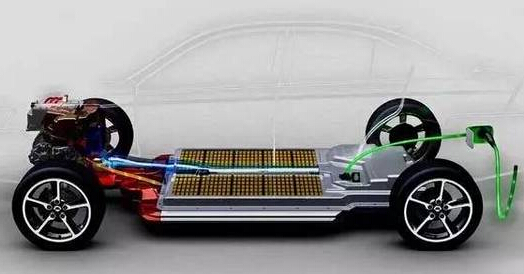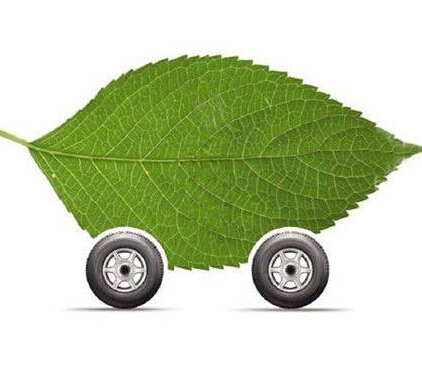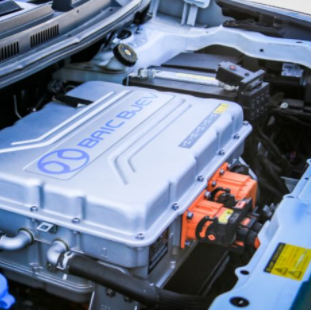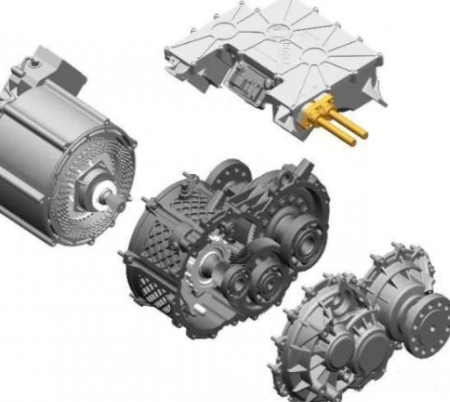
The most important technology that distinguishes a new energy vehicle from a traditional automobile is the "three powers", that is, batteries, motors, and electronic controls. At present, the industry has focused most of its attention on the battery industry due to issues such as mileage and safety. The electric drive system consisting of electronic control of the motor that directly determines the main performance indicators such as electric vehicle climbing, acceleration, and maximum speed is less concerned.
So, at what stage is the development of China's electric drive system? What are the development trends and problems?
On June 26, 2019, Gong Jun, the motor responsibility expert of the National 863 Program Energy Conservation and New Energy Vehicle Major Project, introduced the development of China's electric drive industry at the "2019 Nanjing Innovation Week New Energy Automobile Industry Landmark Summit".

National 863 Program Energy Saving and New Energy Vehicle Major Project Overall Group Motor Responsibility Expert Gong Jun
At the same time, the "China New Energy Vehicle Electric Drive Industry Development Report (2019)" (hereinafter referred to as "Electric Drive Development Report"), which is edited by China Automotive Research Center Co., Ltd. and the electric vehicle electric drive system full industrial chain technology innovation strategic alliance, was officially released. A comprehensive assessment of the current status and problems of China's electric drive technology.
Thanks to the abundant rare earth resources, China has become a major producer of drive motors, and many indicators of the drive motor technology produced have reached the international advanced level. However, there are still large gaps between the individual fields, such as the electric drive system integration capability, and the research and development and manufacturing of SiC devices.
1. China's motor industry is fully localized
Gong Jun believes that China has certain advantages in driving the motor industry. With the development of the domestic new energy automobile industry, China's motor industry has also made great progress. The domestic drive motor industry chain is perfect, and independent motors always occupy an absolute share. At present, only a few passenger vehicles use the electric drive system of foreign-funded enterprises. China has formed a complete industrial chain including drive motors, motor controllers, transmissions, electric drive assemblies, key materials and key components, and has achieved domestic production. Chemical.
According to the statistics of the China Association of Automobile Manufacturers in 2018, the proportion of China's self-supporting drive motors, motor controllers and electric drive assemblies is over 95%. China's new energy vehicle announcement has more than 200 motor and motor controller manufacturers, of which the top 20 manufacturers account for more than 70% of the total, and the market concentration is relatively high. In particular, in the field of commercial vehicles, all localization facilities are basically realized.
The development of China's drive motor industry has shown a diversified trend. At present, it is represented by independent electric motor suppliers such as Shanghai Electric Drive, Jingjin Electric, Shanghai Dajun, CZ Zhuzhou, and United Electronics. Some products have been exported; Suzhou Green Control, Nanjing Yuebo and other commercial vehicle powers have always become representatives. The company's independent research and development, production of electric motors and electronic control, mainly for commercial vehicles; and BYD, Beiqi New Energy, Changan, Chery, Weilai and other vehicle-developing enterprises, through independent construction, joint venture cooperation, etc., research and development, Production of electric drive systems.
 Precision electric three-in-one electric drive assembly
Precision electric three-in-one electric drive assembly
China's drive motor production accounts for more than half of global production. Statistics show that the motor capacity of China's major drive motor companies has exceeded 3 million units (sets). In Gong Jun’s view, China is already a veritable driving motor producing country.
2. There is not much difference between China's overall electric drive level and international advanced level.
Is China considered to be a driving power motor? From the performance indicators, China's motor is not bad. At present, many indicators of motor technology produced in China have reached the international advanced level.
According to the "Electric Drive Development Report", the power range of China's independently developed drive motor series products meets the demand for various new energy vehicles below 250kW. In terms of key technical indicators, the power density and efficiency of China's drive motors are basically equal to the international level.
 Passenger car electric drive system
Passenger car electric drive system
Specifically, China's drive motors continue to advance in terms of power density, system integration, motor efficiency and speed, winding manufacturing process, cooling and cooling technology, and keep pace with foreign advanced levels. According to Gong Jun, China has developed prototypes and products with a power density of 4.5-4.6kW/kg, with a maximum speed of 13,000-16,000 rpm, and integrated electric drive integration. The motor cooling method covers water cooling and oil cooling. And many other types. In terms of specific enterprises, Jingjin Electric developed a commercial vehicle direct drive motor with a torque density of 20.3 Nm/kg. Beijing Pate applied the flat wire technology to develop a 3500 Nm outer rotor direct drive motor, which shows that China's high-density drive motor and commercial The car motor has reached the international advanced level.
In terms of motor controllers, Shanghai Electric Drive, Shanghai Dajun, CRRC Times, etc. have launched their own automotive IGBT chips, double-sided cooling IGBT module package and high power density motor controller, which also explains China's high-density motor controller. The level is rapidly catching up with the international advanced level. For example, Shanghai Dajun United Shanghai Road developed a dual-motor controller with a double-sided water-cooled structure, input power of 260 kW, and motor controller power density of 23.5 W/L. This product has comparable power density specifications compared to Bosch's dual motor controller.
Gong Jun believes that in China's new energy automobile industry chain, the advantages of driving motors are obvious, which is mainly due to the large reserves of rare earths in China.
However, many companies are also trying to get rid of the dependence of motors on rare earths. Foreign companies represented by Toyota and GM began to study the possibility of replacing NdFeB materials with partially mixed magnets (including ferrites), and developed prototypes for verification; low-level heavy rare-earth permanent magnet materials have been used in the Honda Accord. Such as the implementation of batch applications on new energy vehicles.

Magna electric drive axle system
3, the hub motor, 48V is also a hot spot
Some hotspots in the development of the electric drive industry are also worthy of attention, such as hub motors and 48V systems.
In Gong Jun's view, the hub motor is an important development direction of the new energy permanent magnet synchronous drive motor, but there is still a long way to go before mass production applications. Some universities, research institutes and car companies in China have increased their investment in research and development of wheel hub motors. The typical domestic enterprise that uses hub motors is BYD, which has successfully developed wheel hub motors (wheel motors) on passenger cars.
However, the hub motor currently has problems such as difficulty in integration optimization design and high power density performance requirements. The application in commercial vehicles and special vehicles has begun, but it still takes a long time to apply on high-speed passenger cars.

Hub motor
In addition, the 48V BSG integrated integrated assembly has attracted the attention of many powertrain integrators in foreign countries due to its high cost performance. For example, the mainland, Bosch, Valeo, Marelli, South Korea LG have launched the 48V BSG prototype. According to the "Electric Drive Development Report", the mainland, Bosch and Valeo have already equipped with 48V system integration capability (BSG+Battery+DC/DC), which has already achieved loading test and small batch trial production, and the fuel efficiency improvement rate is as high as 12%-15%.
According to Gong Jun, the level of China's 48V BSG assembly is basically the same as that of foreign countries. It has formed industrialization capabilities in key components such as 48V BSG, DC/DC converter and 48V power battery. However, in terms of integration capabilities, China still needs the development of advantageous resources within the United Nations.
4, high power semiconductor external dependence, high silicon carbide devices, a large gap
Of course, there are certain shortcomings in the development of China's electric drive industry.
First of all, the industry lacks recognition of domestic power electronic devices. Gong Jun believes that global high-power semiconductors are still occupied by foreign companies. Due to the high-power power electronic devices such as IGBTs in new energy vehicles, the life expectancy is more than 20 years, the power cycle is tens of thousands or even more than one million times, and it needs to work in different environments and climates. Therefore, it is reliable and reliable. Sexual requirements are very strict, and most domestic companies use imported products. According to statistics, about 90% of new energy vehicle IGBT electronic products required by the Chinese market need to be imported, mainly from Europe, America and Japan.
Secondly, China's technical research on SiC (silicon carbide) materials and devices started late, and the gap with foreign advanced levels is large. However, many research institutes in China have begun research and made some progress. According to the "Electric Drive Development Report", the 55th Research Institute of China Electronics Technology Group Corporation, CZ Zhuzhou, BYD, and Beijing Tyco Tianrun have conducted research on SiC power devices. Tyco Tianrun has supplied 1200V products to the market, and CRRC Times Electric has developed a hybrid module sample of 1700 Si IGBT+SiC Diode.

Dispositivo di alimentazione SiC
Allo stato attuale, la sfida per i dispositivi SiC è che il costo è troppo elevato: il costo di preparazione del materiale è elevato, il processo di produzione di massa è immaturo, con una conseguente bassa resa. Si prevede che dopo 2-3 anni, il processo di produzione dei dispositivi MOSFET SiC diventerà maturo e l'applicazione dei dispositivi SiC sarà ottimizzata.
La capacità di integrazione dei vecchi produttori di sistemi di sistema nel mondo è molto forte e i vantaggi sono evidenti. "In Cina, Magna, GKN, Siemens e altre società rappresentate sistemi di trazione elettrica integrator hanno lanciato un gruppo integrato azionamento elettrico di prodotti, tra cui l'elettronica di potenza e guidare livello di assieme motoriduttore, diventando passeggero Il principale tipo di applicazione del sistema di guida. "Ha detto Gong Jun.
Secondo Gong Jun, i costi di produzione del motore in Cina rimangono alti. Ciò è dovuto principalmente ai prodotti personalizzati più la Cina a motore, anche se una parte di ciò che può essere generico, modulare, ma l'aspetto non è la stessa, quindi per gli ingegneri di avere un certo livello più alto, che ha anche sollevato il costo delle risorse umane.
Per questi problemi, Gong Chun ha suggerito prima, per giocare ad alto livello vantaggi di progettazione, aumentare la ricerca e lo sviluppo, e promuovere il processo di settore dei semiconduttori in Cina, in secondo luogo, accelerare sviluppo di nuove tecnologie e l'innovazione, continuando a rafforzare la competitività del settore energetico cinese guidato, in terzo luogo, È necessario condurre joint ventures e collaborazioni in varie forme nel settore globale, esportare comparative comparative e promuovere lo sviluppo dell'industria automobilistica cinese. (Fine)
















 RCCN WeChat QrCode
RCCN WeChat QrCode Mobile WebSite
Mobile WebSite




